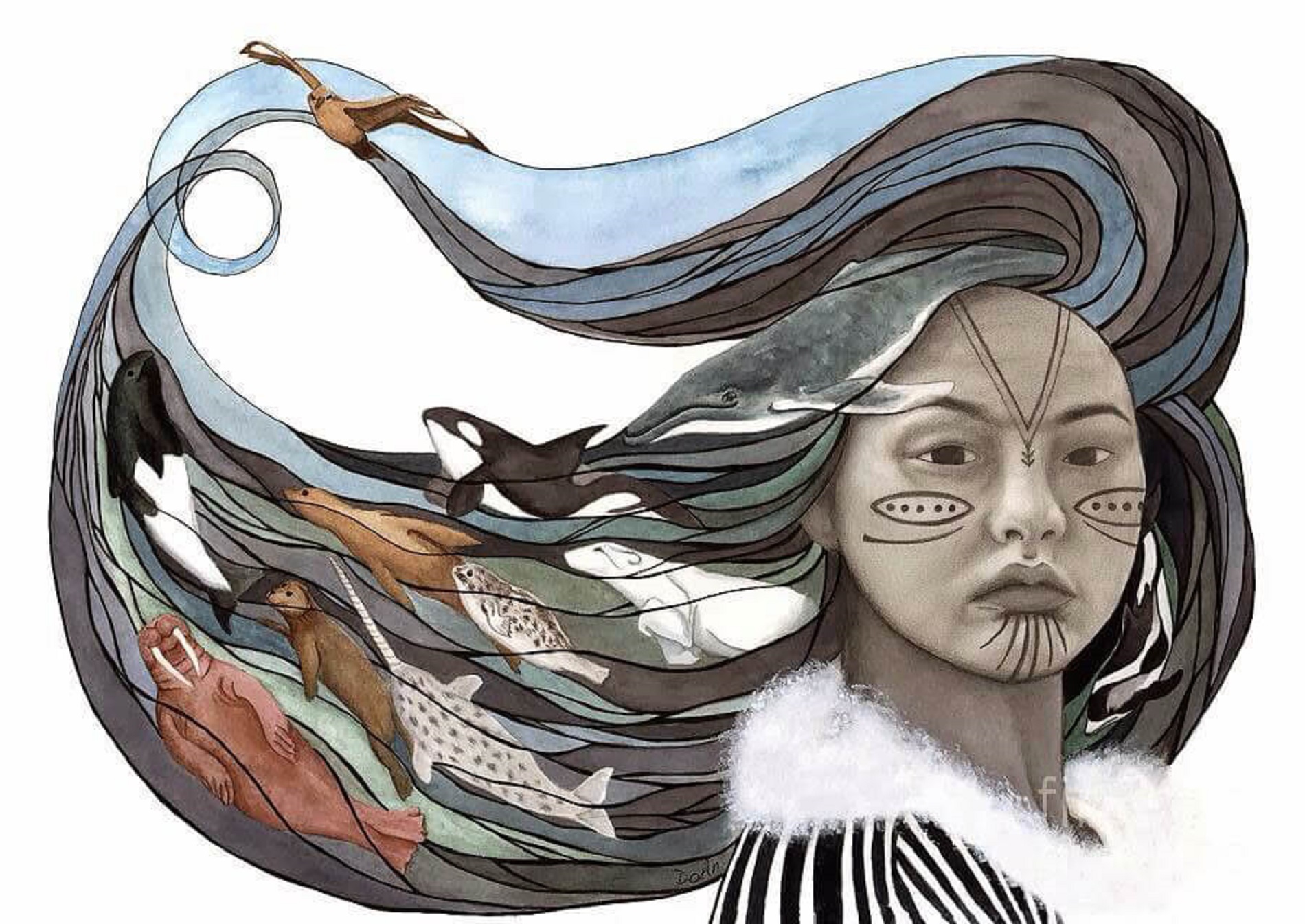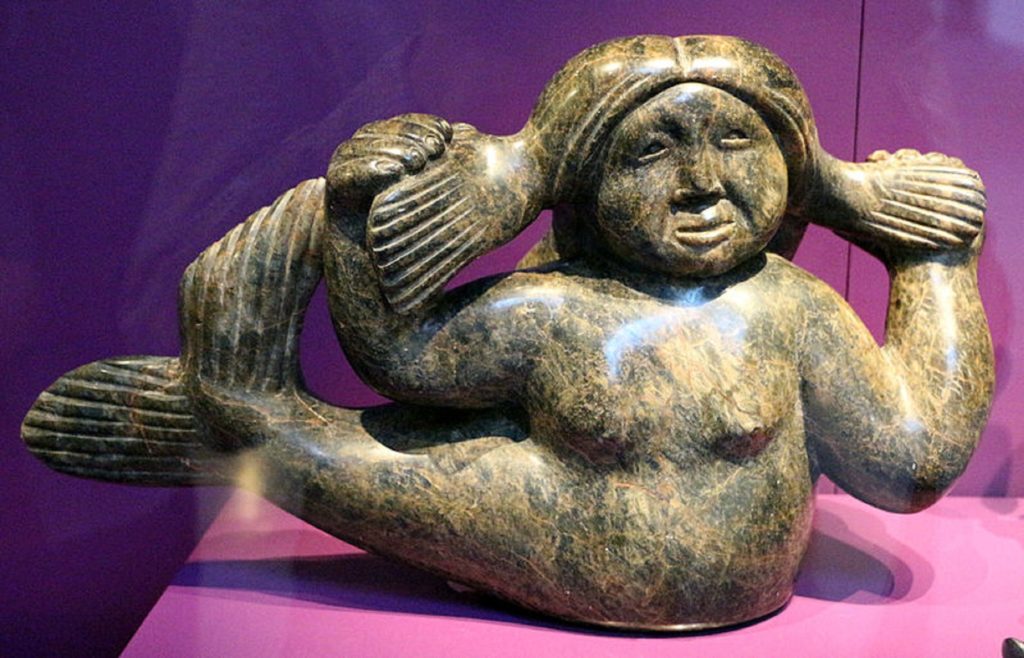
Recently a friend of mine sent me a short video regarding a Goddess of the sea I was not aware of but am very much appreciative that I now know of her. Across the lands of the Inuit culture she has many names such as Mother of the Seas, Nuliayuk (Nuliajuk), Taluliyuk but most commonly she is known as Sedna. I immediately dived into learning about her and for those who personally know me know how much I love the Gods and Goddesses of the seas. So I felt an important need to share with you all the story and importance of this Inuit sea goddess that is certainly one of the most celebrated within the Inuit pantheon.
One thing I want to express which is very important to me out of respect to the Inuit nation is this. The Inuit are a proud people with a rich culture, traditions and history which really deserves to be preserved and respected.
SEDNA – (also known as Nuliajuk) – The sea goddess and the most celebrated deity in the Inuit pantheon. Even mythology books that cover no other figures from Inuit myths will usually have an entry on her. She was the daughter of the god and goddess Anguta and Isarrataitsoq and, like countless female figures in Inuit myths, she refused all prospective husbands. Sedna instead had sexual relations with dogs and the “freakish” offspring of these unions were said to be white people and Native American tribes that the Inuit were often at war with.
A ghoulish twist to the story is how Sedna took to using her parents as food (a recurring theme in Inuit myths because of the scarcity of food in the frozen north at times and how instances of cannibalism during such famines were much-discussed). Sedna devoured both of her mother Isarrataitsoq’s arms and had finished eating one of her father’s arms before he was able to subdue her and take her out to sea in his canoe, intent on banishing her to the sea. Continuing to struggle, Sedna clutched the sides of the canoe as her father tried to submerge her, prompting him to take his long knife and cut off her fingers.
Since, to the Inuit, loss or mutilation of the hands was often seen as a horrific transformation into something new, the myth states that Sedna now embraced her fate, transforming her now-fingerless hands into flippers and transforming her severed digits into the various species of sea animals. When the one-armed Anguta returned to shore, where his still-armless wife awaited, Sedna, now fully realized as the sea goddess, caused a massive wave to wash over her parents, dragging them down to her new home to serve in her subaquatic court. Continue reading HERE.

Once upon a time there lived on a solitary shore an Inung with his daughter Sedna. His wife had been dead for some time and the two led a quiet life. Sedna grew up to be a handsome girl and the youths came from all around to sue for her hand, but none of them could touch her proud heart. Finally, at the breaking up of the ice in the spring a fulmar flew from over the ice and wooed Sedna with enticing song. “Come to me,” it said; “come into the land of the birds where there is never hunger, where my tent is made of the most beautiful skins. You shall rest on soft bearskins. My fellows, the fulmars, shall bring you all your heart and desire; their feathers shall clothe you; your lamp will always be filled with oil, your pot with meat.” Sedna could not long resist such wooing and they went together over the vast sea. When at last they reached the country of the fulmar, after a long and hard journey, Sedna discovered that her spouse had shamefully deceived her. Her new home was not built of beautiful pelts, but was covered with wretched fishskins, full of holes, that gave free entrance to the wind and snow. Instead of soft reindeer skins, her bed was made of hard walrus hides and she had to live on miserable fish, which the birds brought her. Too soon she discovered that she had thrown away her opportunities when in her foolish pride she had rejected the Inuit youth. In her woe she sang: “Aja. O father, if you knew how wretched I am you would come to me and we would hurry away in your boat over the waters. The birds look unkindly upon me the stranger; cold winds roar about my bed; they give me but miserable food. O come and take me back home. Aja.” Continue reading HERE.
Did you know that the farthest known celestial body in space is named after the goddess Sedna?
2003 VB12 was the official temporary designation of the International Astronomical Union (IAU) Minor Planet Center, based on the year (2003) and date (14 Nov = the 22nd 2-week period of the year thus V=the 22nd letter of the alphabet. after that it is sequential based on the discovery announcement) of discovery. Once the orbit of 2003 VB12 is known well enough (probably 1 year), we will recommend to the IAU Committee on Small Body Nomenclature — which is responsible for solar system names — that it be permanently called Sedna (this has now happened, see above) . Our newly discovered object is the coldest most distant place known in the solar system, so we feel it is appropriate to name it in honor of Sedna, the Inuit goddess of the sea, who is thought to live at the bottom of the frigid arctic ocean. We will furthermore suggest to the IAU that newly discovered objects in this inner Oort cloud all be named after entities in arctic mythologies. SOURCE
Further Resources
The Inuit Legend of the Sea Goddess
The Goddess of the Sea: The Story of Sedna
